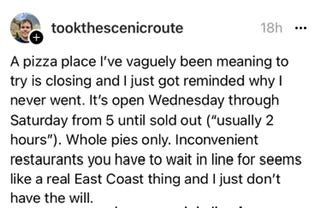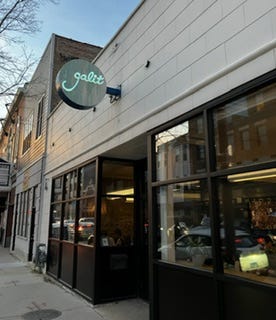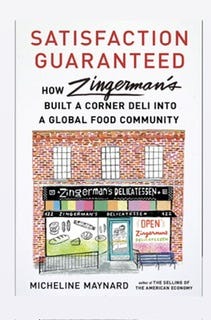Why Some Diners Have Run Out Of Patience
Nearly four years after the pandemic, customers have gotten publicly grumpy
Welcome to the first CulinaryWoman Newsletter for 2024. A very special greeting to our new subscribers. Dozens of you have signed up since New Year’s Day, and I’m delighted to have you join us.
Subscribing allows you to start off with the free newsletter, which will let you see if you like what I’m bringing you each week. But I hope you’ll think about upgrading to a paid subscription for $50 a year (we also offer a monthly price, and if you’re really feeling generous, you can pay more).
CW is funded solely by subscriptions. We do not take ads or have sponsors, so your support is truly appreciated. I’m dedicated to making CulinaryWoman one of your favorite and most useful reads of the week — and the year. Thanks so much for being here!
Schadenfraude For A Pizza Place
Scrolling through Threads late last year (you can find me there (@) michelinemaynard), I spotted this post.
Hmm, I thought, that seems a little harsh. Then, I spotted this response.
And yet another one.
As I read through the thread of comments, I decided to figure out which restaurant they were talking about, and all signs pointed to this one.
Even though Pizzeria Blotto had won attention from the New York Times and earned loyalty from regulars, it was clear that other diners in Seattle were not supportive of the way that it had chosen to do business.
Given the many challenges that restaurants have faced, I could think of numerous reasons why the pizza shop had limited its hours and declined to offer slices during its short lifespan. The proprietors, who began with a pop up, might be running it with limited staff or maybe managing on their own.
Perhaps they believed that full sized pizzas tasted better and more accurately reflected their approach than individual slices. The restrictions could have limited food waste.
But, apparently their choices didn’t sit well with everyone. The naysayers voiced their disdain loud and clear: they wanted their pizza at the hours and in the style that suited them.
Now, you could say, “Fine. Just order Domino’s.” Or, pull a pizza out of the freezer.
But those alternatives won’t keep small places in business. So, there is a conundrum facing owners now: do you operate for your convenience, or try to adjust to customers’ expectations? Make the wrong choice, and you could find yourself going out of business either way.
A solution to keep things clear
Given the uncertainty that still lingers over restaurants, I can’t trust the schedules from the old days that might be baked into my brain. I’ve made it a practice now to check for a restaurant’s latest operating times before I make plans.
Recently, I was driving back from Detroit and wanted to stop in Canton, Mich., on the way home. But a quick check showed the restaurant was closed. I wound up heading home and cooking instead.
Was I mad at the restaurant? No, I’ll get there another time.
I am seeing more and more places step up to keep customers aware of their likelihood of getting food and table reservations. Many do so on social media.
Ever since it opened 18 months ago, Flour Moon Bagels in New Orleans has often seen demand exceed its supply of bagels and bialys. On its Instagram, Flour Moon regularly posts updates on what’s available and lets customers know when it sells out, so they can save themselves a trip to the Lafitte Greenway.
Likewise, our friend Jason Goodenough went to great pains with his latest pop up dinner, a collaboration with chef Kelly Mayhew, to tell diners that only a limited number of seats would be available. The dinner, which will feature Italian specialties, sold out almost immediately.
I’d like to think that diners can be forgive occasional disappointments.
People seem to roll with unexpected events, like power outages or snowstorms. But, if you’ve told them you’ll be open X hours a day, X days a week, and you can’t honor that, you risk losing business and goodwill — and snarky social media posts.
We’re in a time of year when business slows way down, except for a little bump around Valentine’s Day. I’m perfectly fine if a restaurant decides there isn’t enough demand to keep to the hours it operates during sunnier and warmer times of the year. For us up north, these are the months when we hunker down.
However, if there are adjustments, I’d like to hear directly from the establishment so I can make alternate plans. Algorithms can play havoc with Instagram and Facebook posts, meaning things don’t flow into your timeline until hours or days later.
It might require an email or text message to keep everyone informed.
There’s an old saying that a brand is a promise that a business makes to customers. In the case of restaurants, customers are reacting emotionally to what they feel they’ve been promised. Food places need to anticipate the expectations for their category of dining, and act accordingly.
After all, you never want anyone to cheer if you close.
Farewell to an Australian Legend
Just after Christmas, the global food community received some bad news. Bill Granger, arguably one of Australia’s most important culinary figures, died at age 54.
Bill might not have been a household name in America, but if you like to eat upscale breakfasts, you definitely felt his influence. He popularized dishes such as ricotta pancakes, tofu scramble and most famously, avocado toast.
All were served at his restaurants in Australia, Asia and Great Britain, where he turned breakfast and brunch into something beyond ordinary buffets. His ideas crossed oceans and continents.
I played a tiny role in bringing one of his recipes to Ann Arbor. Visiting a cafe in Toronto, I was enchanted by what turned out to be his ricotta pancakes. I asked for the recipe and brought it home to Nick Panos at Nick’s Original House of Pancakes, asking if he could replicate it.
Nick tweaked it a little, adding blueberries, which are plentiful during Michigan summers, and made it an annual special, naming the pancakes after me (the menu is up on the wall in my kitchen).
My sympathies to everyone who loved Bill and his food. He certainly made a lot of diners happy.
Spreading Goodwill In Chicago And Elsewhere
People in the restaurant community know about the custom of family meal. It’s a group repast that’s served to the entire staff, usually in mid-afternoon before a place opens for dinner.
In Chicago, restaurants are taking turns feeding each other. Time Out Chicago reports that chefs across Chicago are gifting staffs with lunch and dinner exchanges.
The treats range from pizza and Italian beef sandwiches to Asian candy, Mediterranean food and fried chicken. Some bars are even sending rounds over to other drinking establishments. Galit, one of my favorite restaurants, is among the participants in the food gifts.
The practice appears to have roots in Europe, where chefs would cook lunch for farmers when they dropped off supplies of vegetables, fruit and meats. The sharing now takes place around the United States, fostering a festive atmosphere as well as a sense of community.
Keeping Up With CulinaryWoman
Before I tell you what I’ve been doing, I want to share this interesting story from RadioWorld that features my brother Frank Maynard. After winding up his career last year as a broadcast engineer for CBS Detroit, he now takes part in the Alternative Broadcast Inspection Program for the Michigan Association of Broadcasters.
Radio and television stations are required to meet certain standards set by the Federal Communications Commission in order to keep their licenses. My brother (on the left in the photo) checks their compliance with areas like the Emergency Alert System (that annoying “baat baat baat” alarm that you hear on radio and TV), broadcast tower lights and the power of their transmission equipment.
Stations’ logs can be kept manually or electronically, but they have to be reviewed and signed off by a station’s chief engineer and available to the inspector. The article gets a little esoteric for non-engineers, but it helps you understand how much it takes to keep a station on the air.
On a lighter topic, while I was getting over the flu during the holidays, I spent some time scrolling through Facebook Marketplace. I was fascinated by the vast amount of vintage fine china, crystal and silverware that was listed for sale. (Someone was offering this Lenox service for 12 for free!) I suspected a lot of it was being sold by people who inherited from late relatives and didn’t know what to do with it.
That inspired me to write this story for The Takeout on caring for and using these wonderful treasures. I inherited two sets of sterling and three sets of dishes from my mother and Maxine, and I’ve decided that I’m going to put it into rotation.
But, unlike my mother, who set a glittering table with everything she owned, I’ve decided to mix and match. For Christmas, I used her Grand Baroque sterling with Pyrex berry bowls that I bought last summer in Petoskey, Mich., and my own La Rochere drinking glasses. It felt like my mother was a guest at our table and it was no trouble to wash up afterwards.
For our newest readers, here are some ways to find and follow me.
Website: www.michelinemaynard.com
Email: culinarywoman (@) gmail dot com
LinkedIn: Micheline Maynard
Threads and Instagram: (@) michelinemaynard
Tomorrow, I’ll be back with Red Beans & Advice for our paid subscribers. I’ll be talking about one of my favorite pastries: king cake. Yesterday was the official start of Carnival season in New Orleans, and king cakes are everywhere, in many forms and flavors.
The CulinaryWoman Reading Room, another paid feature, also returns this week, when I’ll talk about a book that has kept up my spirits while I’ve been trying to eat healthy.
On Tuesday, everyone will get the first edition of Food News, featuring an entrepreneur here in Ann Arbor. Speaking of my home town, I hope you’ll cheer for the Michigan Wolverines in tomorrow’s college football national championship. Go Blue!
Thanks for joining me at the beginning of 2024! Have a good week.
Satisfaction Guaranteed: How Zingerman's Built a Corner Deli into a Global Food Community https://amzn.to/3Hk4vAq














I enjoyed your perspective about the challenges restaurants face. In that, you asked “there is a conundrum facing owners now: do you operate for your convenience, or try to adjust to customers’ expectations?”
There is only one answer for a restaurant: Unless it’s owner(s) have an endless supply of money and aren’t focused on earning a profit, the restaurant must meet customer expectations if it wants to remain in business. And that may require some compromising on the owner’s part. The owner may not want to sell slices of pizza, for example, but if that what people want to buy, the owner needs to figure out how to do that. For example, maybe sell slices only during lunch time. And at the same time, we as customers need to understand and respect what the owner is trying to do with her/his business. That may mean accepting we can only buy a slice of pizza at lunch time, and hole pies at dinner.
But there also needs to be a commitment by the owner to the public. Having random hours, or telling me you only sell bagels until you run out, makes the business appear to be unreliable. You may sell the best bagel in town, but at the end of the day it’s a bagel. If you only sell until you run out, but another nearby bagel shop has defined hours and adequate inventory, who’s ultimately going to succeed? A well-run restaurant or food business should be able to track sales and forecast the inventory it needs to meet customer demand - while managing food costs (and waste), staff time, etc.A bagel shop, for example, may not have enough inventory of every flavor, but it know how much of its top three to five sellers it needs to make to meet expected demand during its posted hours of business.